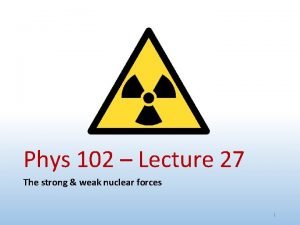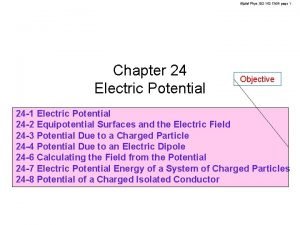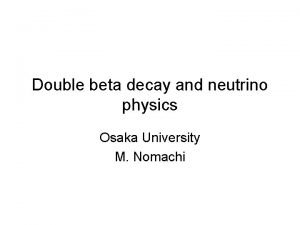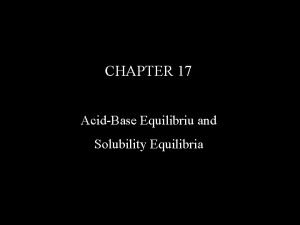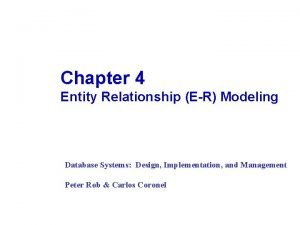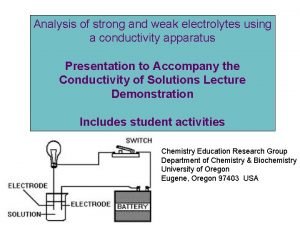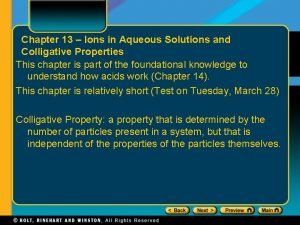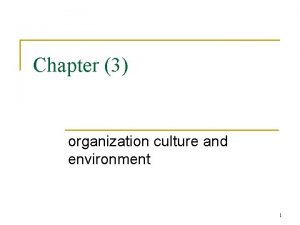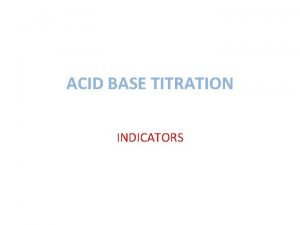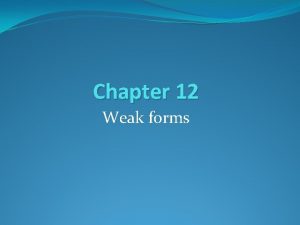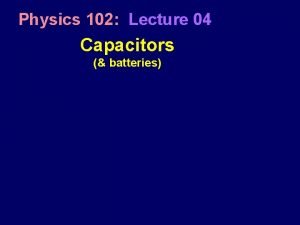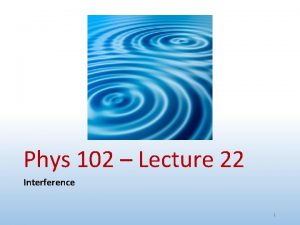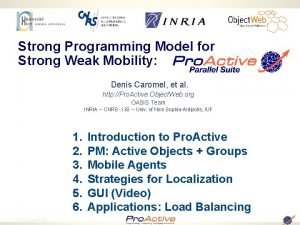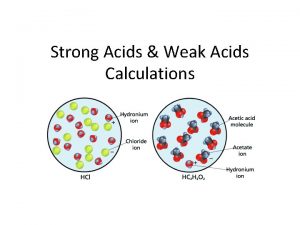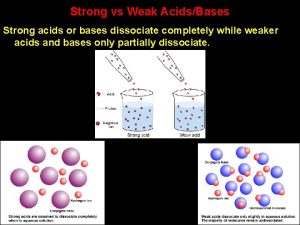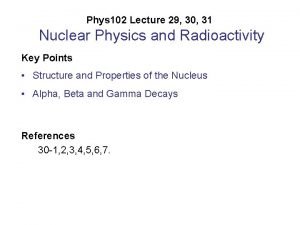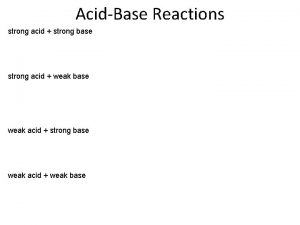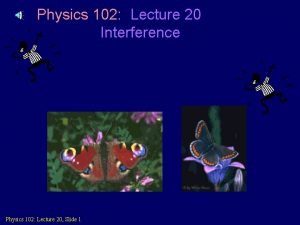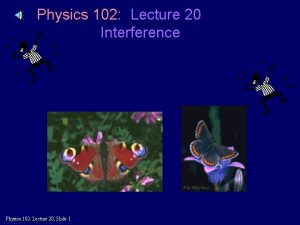Phys 102 Lecture 27 The strong weak nuclear






















- Slides: 22

Phys 102 – Lecture 27 The strong & weak nuclear forces 1

4 Fundamental forces of Nature Today Gravitational force (solar system, galaxies) Electromagnetic force (atoms, molecules) Strong force (atomic nuclei) Weak force (radioactive decay) < Gravitational weakest < Weak Electromagnetic < Strong strongest

The nucleus All + charge of the atom is inside a small nucleus, which is made up of protons and neutrons (“nucleons”) Particle electron proton neutron Mass (Me. V/c 2) 0. 511 938. 3 939. 5 Charge –e +e 0 Phys. 102, Lecture 27, Slide 3

Nuclear nomenclature A nucleus is composed of Z protons and N neutrons (“nucleons”) A = “atomic mass number” Element name Z = “atomic number” A = nucleon number (gives mass of nucleus since ) Z = proton number = electron number (gives element name & chemical properties) Ex: Elements with different nuclei are known as isotopes + “protium” + + “deuterium” “tritium” Phys. 102, Lecture 27, Slide 4

ACT: Check. Point 1. 1 A material is known to be made from an isotope of lead (Pb). Based on this information which of the following can you specify? A. The atomic mass number B. The neutron number C. The proton number Phys. 102, Lecture 27, Slide 5

Nucleus size Mass densities of nuclei are approximately the same and so fm “femtometer” Ex: deuterium (1 proton + 1 neutron) Ex: 104 – 105 Compared to size of atom (outer e– shell) How do protons not repel each other inside nucleus? Phys. 102, Lecture 27, Slide 6

Strong nuclear force Electric potential energy of two protons in 1 fm nucleus: Strong nuclear force binds nucleons together, overcomes Coulomb repulsion at fm distances E Ex: deuterium (1 proton + 1 neutron) Attractive strong force ~fm ~Me. V 105 Coulomb repulsion r DEMO Phys. 102, Lecture 27, Slide 7

Binding energy & mass defect Nuclear binding energy decreases mass of nucleus Einstein’s equation: Equivalence of mass and energy “Mass defect” Ex: deuteron = 1 proton + 1 neutron + + Phys. 102, Lecture 27, Slide 8

ACT: Binding Energy Which system “weighs” more? A B A. Two balls attached by a relaxed spring B. Two balls attached by a stretched spring C. They have the same weight Phys. 102, Lecture 27, Slide 9

Binding energy plot Binding energy per nucleon increases with A due to higher strong force, then decreases due to Coulomb repulsion FUS ION FISSION Fission = Breaking large nuclei into small (ex: nuclear reactors) Fusion = Combining small nuclei into large (ex: stars) Phys. 102, Lecture 27, Slide 10

ACT: Uranium mass 238 U is long-lived but ultimately unstable. Eventually, it will spontaneously break into a 4 He and 234 Th nucleus, and release a tremendous amount of energy: What must be true about the masses of the nuclei? A. B. C. Phys. 102, Lecture 27, Slide 11

Radioactive decay There are 3 types of radioactive decay: α particle: Easily stopped nucleus β– particle: electron Stopped by metal γ radiation: photon (more energetic than x-rays) Penetrate Phys. 102, Lecture 27, Slide 12

ACT: Types of radioactivity Consider the following trajectories from α, β–, and γ sources B field into page 1 2 3 Radioactive sources detector Which of the trajectories must belong to an α particle? A. 1 B. 2 C. 3 Phys. 102, Lecture 27, Slide 13

Radioactive decay rules 1) Nucleon Number (A) is conserved. 2) Atomic Number (Z) is conserved. 3) Energy and momentum are conserved. α decay: α particle has 2 protons, 2 neutrons: A = 4 Charge is +2 e: Z = +2 β– decay: Electron is not a nucleon: A = 0 Charge is – 1 e: Z = – 1 γ decay: Photon is not a nucleon: A = 0 Charge is 0: Z = 0 “nuclear isomer” excited state Phys. 102, Lecture 27, Slide 14

ACT: Checkpoint 2. 1 A nucleus undergoes α decay. Which of the following is FALSE? A. Nucleon number decreases by 4 B. Neutron number decreases by 2 C. Charge on nucleus increases by 2 Phys. 102, Lecture 27, Slide 15

ACT: Checkpoint 2. 2 The nucleus undergoes β– decay. Which of the following is true? A. The number of protons in the daughter nucleus increases by one. B. The number of neutrons in the daughter nucleus increases by one Phys. 102, Lecture 27, Slide 16

ACT: Decay reactions Which of the following decays is NOT allowed? A. B. C. D. Phys. 102, Lecture 27, Slide 17

Weak nuclear interaction α decay is a fission reaction (strong force vs. Coulomb repulsion) γ decay is transition between nuclear energy levels β– decay converts a neutron into a proton: = “Weak” interaction is mechanism behind this decay process Range only 10– 18 m and 10– 6× weaker than strong interaction! Phys. 102, Lecture 27, Slide 18

Radioactive decay rates Decay reactions are probabilistic Number of undecayed nuclei “Activity” or rate of decay Units: “Becquerel” (1 Bq 1 decay/s) Decay constant “Half-life” = time for ½ of the nuclei to decay Ex: At t = T 1/2, ½ the nuclei survived & the activity decreased by ½ At t = 2 T 1/2, ¼ the nuclei survived & the activity decreased by ¼ Phys. 102, Lecture 27, Slide 19

Calculation: carbon dating 1 in ~8 × 1011 C atoms is 14 C and β– decays with a T 1/2 of 5730 years. Determine how many decays/s per gram of carbon occur in a living organism. Decay constant: Number N of 14 C atoms per gm: Phys. 102, Lecture 27, Slide 20

ACT: Carbon dating In the previous example we found that the 14 C activity in living organisms is 0. 24 Bq per gram of sample. The half-life for β– decay of 14 C is ~6, 000 years. You test a fossil and find that its activity is 0. 06 Bq/gm. How old is the fossil? A. 3, 000 years B. 6, 000 years C. 12, 000 years Phys. 102, Lecture 27, Slide 21

Summary of today’s lecture • Nuclear atom Nuclei composed of neutrons & protons (nucleons) Strong force binds nucleons together -> “mass defect” • Radioactive decay Three types: α (He nucleus), β– (electron), γ (photon) Nucleon number, charge, energy/momentum conserved • Decay rate T 1/2 is time for ½ of nuclei to decay & for activity to decrease by ½ Phys. 102, Lecture 27, Slide 22
 Strong vs weak nuclear force
Strong vs weak nuclear force Ephesians 6:10-20 nkjv
Ephesians 6:10-20 nkjv Physics 102 uiuc
Physics 102 uiuc Aljalal phys 102
Aljalal phys 102 Aljalal phys 102
Aljalal phys 102 101012 bằng
101012 bằng Charging by induction
Charging by induction Fisión nuclear vs fision nuclear
Fisión nuclear vs fision nuclear Lesson 15 nuclear quest nuclear reactions
Lesson 15 nuclear quest nuclear reactions Weak nuclear force
Weak nuclear force Strong and weak bases
Strong and weak bases Strong acid weak base titration graph
Strong acid weak base titration graph Weak acid and weak base reaction
Weak acid and weak base reaction Multivalued attribute
Multivalued attribute Strong nucleophile and weak nucleophile examples
Strong nucleophile and weak nucleophile examples Strong believer is better than weak
Strong believer is better than weak Strong vs weak electrolytes
Strong vs weak electrolytes Strong vs weak electrolytes
Strong vs weak electrolytes Contoh total participation
Contoh total participation Strong and weak organisational culture
Strong and weak organisational culture Weak base strong acid titration curve
Weak base strong acid titration curve Is h3po4 strong or weak
Is h3po4 strong or weak Strong syllable and weak syllable
Strong syllable and weak syllable
